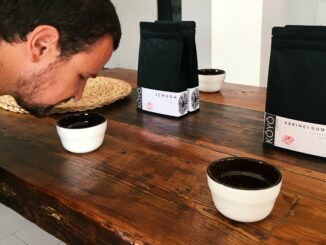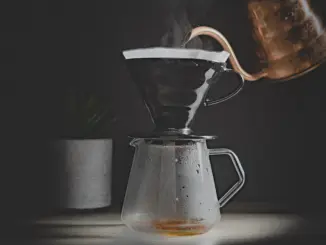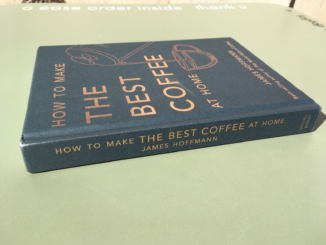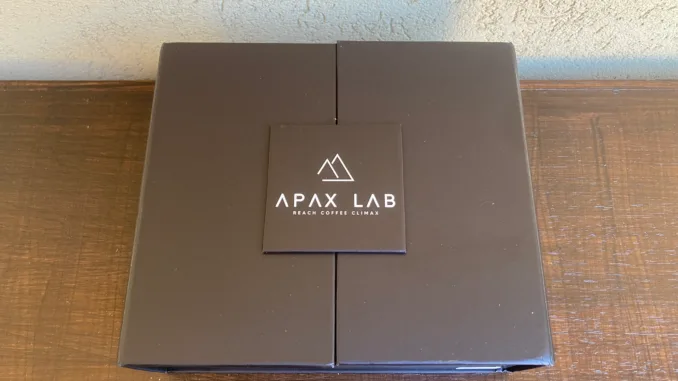
We tried out Apax Lab’s mineral kit, a popular tool for coffee-competition brewing.
BY TANYA NANETTI
SENIOR ONLINE CORRESPONDENT
Photos by Tanya Nanetti
For years I was content to use store-bought filtered water when I wanted to brew a delicious cup at home. That all changed a few months ago when I stumbled upon Martin Wölfl’s page by chance. Recently crowned World Brewers Cup Champion, Martin listed as part of his winning routine a special water he created by blending the three different mineral concentrates produced by the Australian brand Apax Lab.
About Apax Lab
A quick look at Apax Lab’s website piqued my interest, for several reasons.
First, the concentrates were presented as comparable to a food seasoning, developed to easily “season” a specific coffee according to personal preference, in the same way one would add a spice to a dish to achieve the desired characteristics. Unlike other water kits, Apax Lab’s concentrates were designed with a dual purpose: to create a specific water for brewing, and to be added to already brewed coffee, either black or with milk. In addition, the kit was intended for home users, coffee shops, coffee competitions, and quality control.
The more I read about the mineral concentrates, the more I wanted to try them.
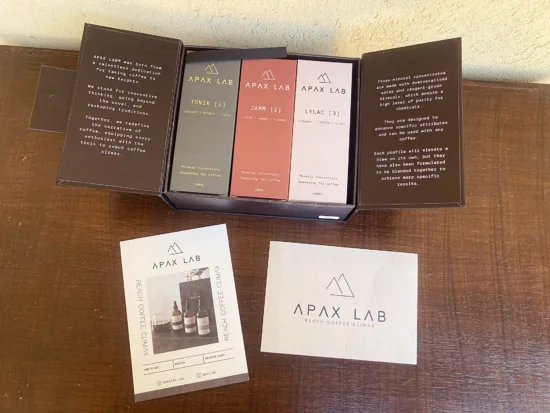
The Mind Behind the Water
While waiting for their delivery, I got in touch with Simon Gautherin, the mind behind Apax Lab, to learn more about the mineral concentrate kit.
“Think of them as the spice rack a chef uses to season food,” Simon began by introducing his creation. “Each concentrate adds distinct effects and can be used directly in coffee to enhance it. Instead of ’flavoring’ the coffee, they highlight its positive attributes such as sweetness, body, and acidity, while reducing less desirable ones such as bitterness and sharpness.”
Next, Simon told me where the idea for the kit came from: “I have been making competition water for seven years and many people have won their national championships with the profiles I designed. I got to a point where many people were asking me to help them remotely, but that can be challenging, so I started putting these winning recipes for championships in smaller bottles that people can easily use.”
I was curious to learn more about the other use of concentrates, to be added after brewing.
“During our research we quickly realized that adding minerals before or after brewing changed little or nothing,” Simon explained. “So we started exploring the possibilities of post-brewing remineralization, effectively giving baristas and brewers the opportunity to taste their coffee, and improve it, after brewing. This is a first, because there was no other way to not substantially transform the profile of the cup after brewing, but to do it with incredible precision and get exactly what you want in the final cup.”
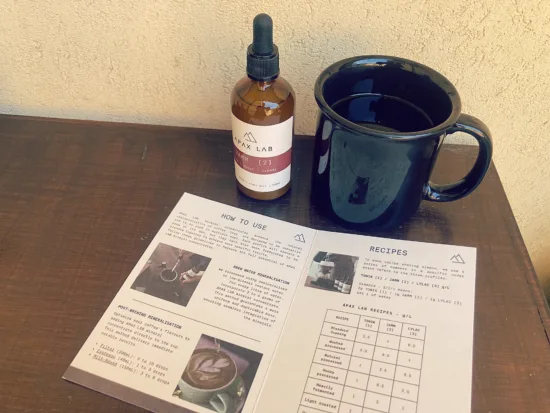
Choosing Your Water
I was just finishing my chat with Simon when I finally got my Apax Lab kit delivered. Excited, I wanted to start preparing my water right away, but I still had a couple of things to figure out before I started.
First, finding the right water to start with.
After reading all about what water was best to use (distilled, demineralized, purified), I realized that I had no idea where to find any of the suggested types of water. Fortunately, a local coffee friend steered me toward bottled water that was soft enough to be used as a base for my mineral concentrates.
It was not the best solution (too much waste produced), but for the moment it was the easiest.
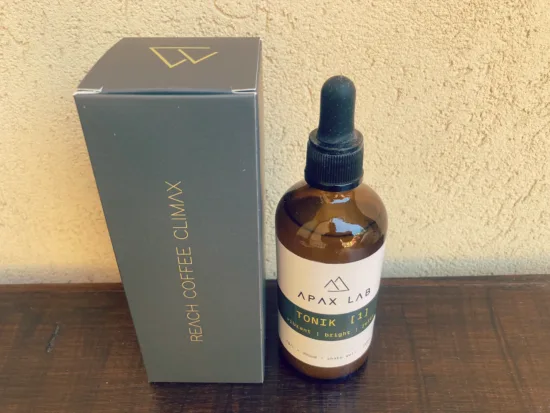
Three Solutions
Then, I just needed to decide which recipe to use to make my water. I had diligently studied the three different concentrates and thought I knew enough.
The first concentrate, Tonik, is formulated to enhance the vibrant acidity of a coffee, imparting a crisp, intense, and juicy note to the brew. It’s suitable for infusing washed coffees in general—Ethiopian and Kenyan coffees, along with Gesha, Sidra, and other varieties characterized by floral characteristics.
The second concentrate, Jamm, is designed to help amplify the role of calcium and bicarbonate. It’s formulated to enhance the richness and depth of the coffee, accentuating the lingering sweetness and creaminess in the mouth of the brew. Perfect as an addition to any coffee that has undergone some sort of fermentation and can take its sweetness to new levels, it has been suggested for brewing naturally processed coffees, with a focus on South American and Southeast Asian beans.
The third and final concentrate, Lylac, is made to harness the qualities of sulfate and potassium, emphasizing the delicate and floral characteristics of coffee. This ensures an elegant, refined, and graceful addition to the brew, with a silky mouthfeel. It was suggested as a perfect match for any coffee with distinct floral characteristics (Gesha, Sidra, Chiroso, Pink Bourbon), and for brewing honey-processed beans and coffees from Central America.
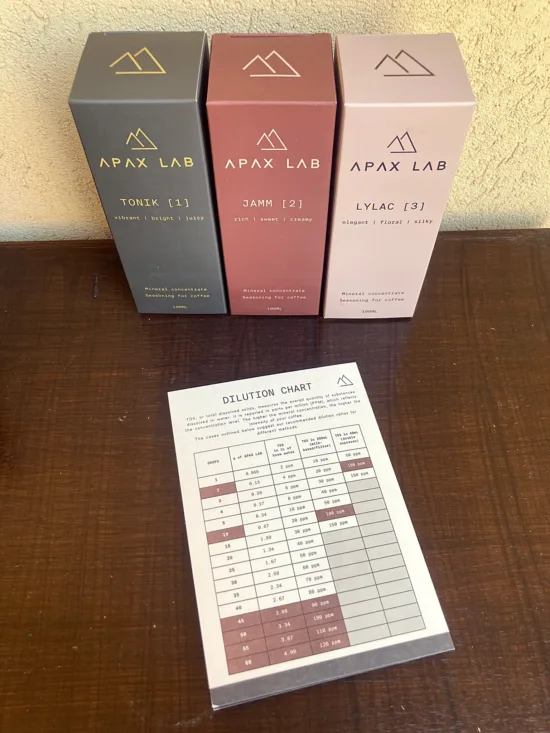
Mixing and Matching
The problem was choosing how to mix them to best match Diego Bermudez, the super-fruited, light-roasted, and thermal-shock fermented Colombian coffee (roasted by Manhattan Coffee Roasters) I wanted to brew.
Scanning through the recipes included in the package, I decided to start by comparing two recipes that seemed to suit my coffee: the one for heavily fermented beans and the one for light roasts.
Brewing With Apax
Once I chose the recipe, the rest was a snap. After a simple calculation (to recalibrate the 1 liter recipe to my 1.5 liter bottles), I put the first bottle on a scale (to be more precise). I started adding the concentrates drop by drop, following the drop count included in Apax Lab’s dilution chart (15 drops = 1 gram) until I reached the required weight of each specific concentrate.
After doing the same for the second recipe, it was time to start brewing the coffee. I used the exact same brewing recipe for each of the two prepared waters.
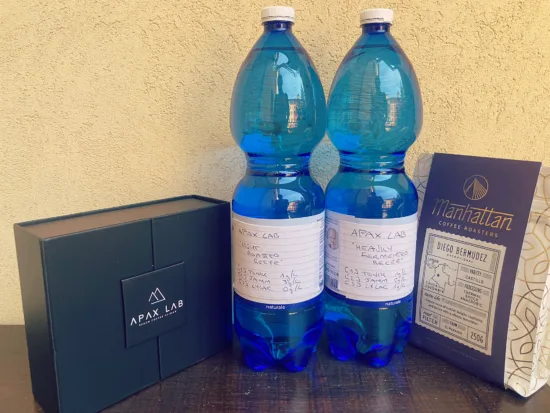
As I imagined, the two coffees tasted very different. The first (light roast recipe) was milder and sweeter. The second was more vibrant, balanced and elegant—more complete. It was amazing how different a coffee tasted just because of the different amount of added minerals!
The next morning, I decided to try using the concentrates for post-mineralization by adding a few drops to my morning flat white. Following Simon’s advice, I opted for a few drops of Jamm and Lylac in the coffee, made with a medium-roast arabica blend that was not too special. I was once again amazed at how the taste of the flat white changed from the previous morning: sweeter, smoother, incredibly rich.
I spend the rest of the week changing recipes and experimenting, following Apax Lab’s suggested recipes for brewing new coffees, creating interesting new recipes (with mixed results), and appreciating the full potential of Apax Lab’s concentrate kit.
All in all it was an illuminating experience. And for me, it’s easy to understand why Apax Lab has been chosen by so many coffee champions to prep their brewing water.
ABOUT THE AUTHOR
Tanya Nanetti (she/her) is a specialty-coffee barista, a traveler, and a dreamer. When she’s not behind the coffee machine (or visiting some hidden corner of the world), she’s busy writing for Coffee Insurrection, a website about specialty coffee that she’s creating along with her boyfriend.
Subscribe and More!
Out now: It’s the October + November 2024 issue of Barista Magazine! Read it for free with our digital edition. And for more than three years’ worth of issues, visit our digital edition archives here.
You can order a hard copy of the magazine through our online store here, or start a subscription for one year or two.



